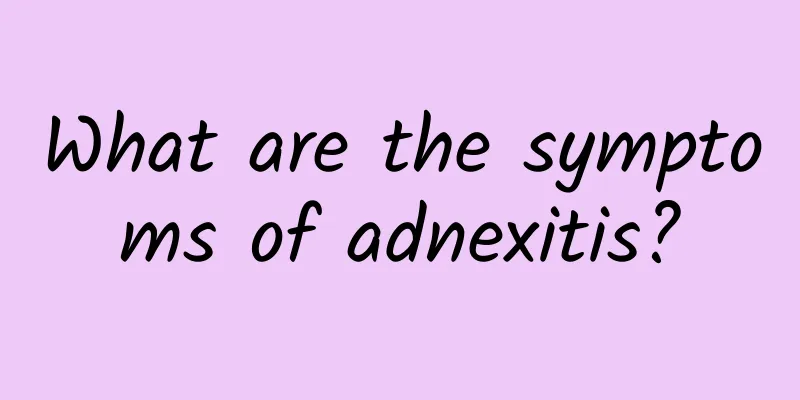What are the symptoms of adnexitis?

|
What are the symptoms of adnexitis? Nowadays, the rampant gynecological diseases seriously endanger the health of women. Adnexitis is one of them. Among the female internal reproductive organs, the fallopian tubes and ovaries are called adnexae. As the name suggests, adnexitis refers to the inflammation of the fallopian tubes and ovaries. So, what are the symptoms of adnexitis? Let's learn about it together. 1. Acute adnexitis. The main symptom is acute lower abdominal pain, accompanied by fever. During gynecological examination, there is obvious tenderness and rebound pain in the adnexal area. Routine blood tests can show an increase in white blood cell count and a significant increase in the proportion of neutrophils. If acute adnexitis is not treated in time or is not treated thoroughly, it can turn into chronic adnexitis. 2. Chronic adnexitis. Patients with chronic adnexitis are relatively common, and their symptoms are mainly manifested in the following aspects. 1. Abdominal pain of varying degrees. The patient experiences symptoms such as lower abdominal distension, pain, and lumbar pain, which may be mild or severe, accompanied by increased leucorrhea, back pain, menstrual disorders, etc., and often worsens during menstruation or after fatigue. 2. The appearance of a tender "lump". During gynecological examination, there is tenderness, thickening, or a tender mass in the bilateral or unilateral adnexal area, and the white blood cell count is elevated or normal. 3. Hydrosalpinx. Chronic inflammation of the fallopian tubes can lead to fibrosis, thickening and obstruction of the fallopian tubes over time, and can also cause adhesions with surrounding tissues. If both ends of the fallopian tubes are blocked, hydrosalpinx can form, and the accumulated water can penetrate into the ovaries that are adhered together, forming a fallopian tube cyst. Experts emphasize that if acute adnexitis is not treated in time, it can turn into chronic adnexitis, which has a great impact on the patient's normal life. If chronic adnexitis is not treated thoroughly, it can induce infertility or ectopic pregnancy. Therefore, once the disease occurs, you should go to a regular hospital for further examination and diagnosis in time. Clinically, the treatment of adnexitis is mainly divided into two types: drug conditioning and surgical treatment. Since each patient's condition is different, the treatment methods used are also different. Experts remind female friends to pay more attention to personal hygiene and eating habits, avoid sexual intercourse during menstruation, and seek medical attention as soon as possible if they find discomfort. |
<<: How is ultrasound diagnosis of uterine fibroids performed?
>>: How to improve the cure rate of threatened abortion
Recommend
Does whole milk make you thinner? Doctor's divine answer
Current scientific research does not believe that...
Common symptoms of cervicitis
Cervicitis is a disease that many women suffer fr...
Let the experts introduce the treatment methods of cervical hypertrophy
As more and more patients with cervical hypertrop...
What are the common causes of cervicitis?
The most common disease among female compatriots ...
3 keys to making your child superior! Nutritionist: Sleep, calcium and vitamin D are essential
Many parents complain to each other that their ch...
Experts teach you how to correctly understand ectopic pregnancy
Ectopic pregnancy is a common gynecological disea...
How to effectively treat female cervical erosion? Is cervical erosion serious for women?
What is the most effective way to treat cervical ...
Why do white spots appear on the vulva during menopause? What causes white discharge from the lower body during menopause?
As women age, their bodies go through a series of...
Bartholin's gland cyst treatment
Bartholin's gland cyst is formed by the obstr...
Getting fatter the more you lose weight? Nutritionist advice: Break these three myths first….
A young girl came to me and said she wanted to lo...
Can I get pregnant after removing a uterine cyst?
Whether you can get pregnant after removing a ute...
How to treat chest tightness and shortness of breath during menopause? Let's take a look
If you have chest tightness or shortness of breat...
Stop dieting to lose weight! Nutritionists share tips on healthy sugar-reducing diets and a complete guide to eating out menus
For people who want to control their weight stead...
Is cervical erosion moderately serious? Do I need to take medicine?
Moderate cervical erosion is usually not a very s...
Where to treat cervical warts
Sitting and waiting for death is not an option fo...









